1970s Fashion Ads 1977 Skokie Illinois

Way in the early on 1990s was generally loose plumbing fixtures and colorful. Unless you were going for the grunge await, then color was the enemy.
Who remembers pegging Skidz pants bought from Merry Go Round? We had to clothing Air Jordans, too. Our t-shirts were large and our shorts were extra long.
Tapered pants were a large bargain. If they weren't tapered, so yous had to taper them yourself with a fold and a couple flips.
Boys and girls both wore baseball game caps in many dissimilar ways. Mullets were stylish for a couple years and every sweater had a turtleneck under it.
Simply and then grunge happened. Of a sudden every thrift store in boondocks couldn't go along a flannel shirt in stock to salvage their backs. Teens were digging through dad's box of former clothes to get their easily on some authentic hole-ridden jeans to clothing over pinnacle of their long john stockings.
Barbers near went out of business organisation considering no one under 17 got their hair cutting any more (OK, nosotros may be exaggerating just a lilliputian.)
Too in the early on nineties fashions worn by hop hop artists were becoming increasingly mainstream. And because of the growing popularity of hip hop music among the suburban community, urban styles were seen everywhere, not just in the big city.
Past the late 1990s hip hop style was arguably the most pop among young people.
Starting in the mid-90s, industrial and military styles crept into mainstream fashion. People were finding whatever way to make a fashion accessory out of a slice of machinery. Camouflage pants were ironically worn by anti-state of war protesters.
By the late 90s, rave culture swept through and people were looking for clothes that were more than glamorous again. The grungy styles of the early nineties were old lid. Looking rich was cool once again. Name brand designers were back in a large way.
Interestingly enough, belatedly 90s clothing styles are non likewise drastically different than they are today. In the 1990s, musicians had a much greater influence on what young people wore than designers. All a kid in Kansas had to do was turn on MTV for the latest due east and west coast styles of the moment.
For significantly more detail about a certain yr in 1990s fashion, click on the plus sign next to the year below.
QUICK REFERENCE LINKS
1990s Fashion Timeline
1990 | 1991 | 1992 | 1993 | 1994 | 1995 | 1996 | 1997 | 1998 | 1999
1990s Style: In-Depth Profiles
1990s Fashion: Pictures
In-Depth 1990s Manner Profiles
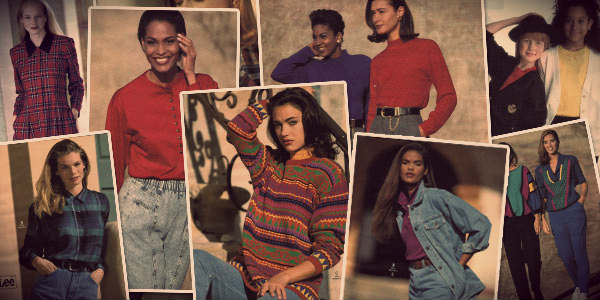
1990s Style: Women & Girls »
1990s fashion for women is embarrassing to some, awesome to others. From teased pilus to turtlenecks, check out our flick gallery of nineties fashion!
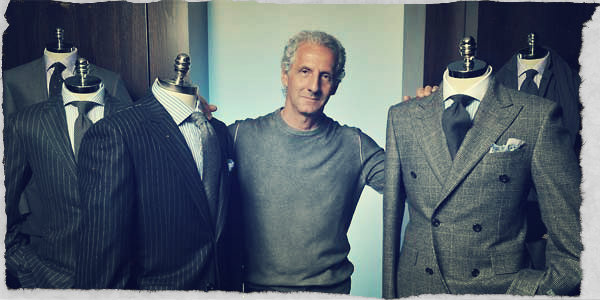
Joseph Abboud: Fashion Designer Facts, History & Pictures »
Joseph Abboud focuses on lifestyle every bit much as design. Even since his Ralph Lauren days, he has given both men and women clothes they tin clothing every day.
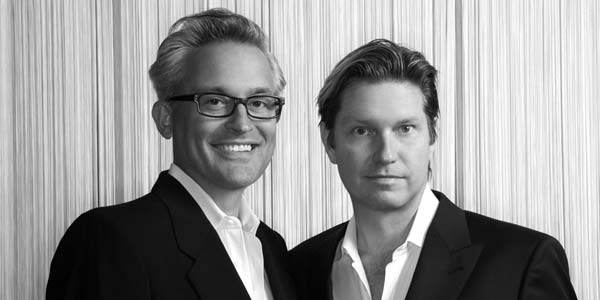
Badgley Mischka: Fashion Designer Facts & History »
Designers Mark Badgley and James Mischka combined their talents to create women's clothing that radiates youthful confidence. They made elegance attainable.
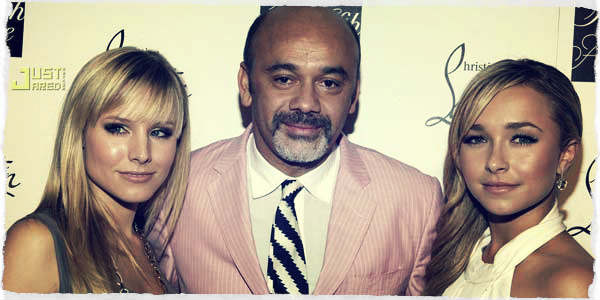
Christian Louboutin: Fashion Designer Facts & History »
Christian Louboutin has become the premier shoe designer in the 21st Century. No red carpeting is complete without a pair of Louboutin stilettos on it.
Fashion in 1990

1990 Fashion: Vogue Mag Cover
In 1990, recession-weary shoppers chose to spend money on clothes that would stay in fashion equally long as possible. That meant that the wild shapes and colors of recent years needed to exist toned down.
The jacket remained the key to daytime dress. A trend setter in the jacket trend was Chanel, who introduced loose versions of the famous Chanel jacket slit vertically at the hem. Some were bright colors like hot pink, tangerine and white. Other leaders were Giorgio Armani, and Calvin Klein.
The biggest difference in 1990 fashion was an explosion of color, with alarming arrays of vivid yellow, orange, cherry, purple and green. Neon bright colors could exist obvious as the primary color of a pair of pants — or they could be subtle every bit the color of a pair of shoestrings.
Brocade, embroidered satins and laces were important, only the well-nigh popular mode of eveningwear was the slender black dress, worn quite brusk with black stockings and loftier-heeled shoes.
In the winter of 1990 the brusque, swingy coat was worn in full force. Women loved how racy the coat looked over short skirts. Casual styles, such every bit anoraks and parkas were prominently seen in cold-atmospheric condition climates.
A revival of the interest in fabricated-to-order habiliment occurred in 1990 when women realized that it wasn't more than expensive than ready-to-wear article of clothing. This surprised many mode analysts and drew other designers to New York City, following the success of Arnold Scaasi.
Fashion in 1991
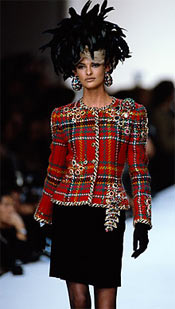
Oscar de la Renta Plaid (1991)
By 1991, the well-known and well-established designers were in their 50's and 60's. Geoffrey Beene, regarded by many equally the almost prestigious designer in New York City, has been the head of his ain fashion visitor for 28 years. James Galanos, whose headquarters is in Los Angeles, has been a fashion leader for 40 years.
Designers everywhere focused on the jacket as the key to contemporary dressing. Denim jackets and leather biker's styles appealed to younger people. For the sophisticated woman, there were long, gently curved jackets from major de signers, such as Giorgio Armani and Karl Lagerfeld of Chanel, also equally less expensive versions without
designer labels.
I wore a long, green, army style Eddie Bauer jacket.
A standard way for women to clothes for the office was to wear one of these longer jackets over a skirt that stopped brusque of the knees. But all kinds of combinations were possible, such equally jackets with trousers, leggings, or tights. Jackets with shorts also gained credence in some areas for more formal daytime vesture, as women wore shorts to offices during the hot summer weather.
For women whose lives did not require formal dressing, including most students, T-shirts, sweat shirts, sweat pants, and jeans were the dominion. Calvin Klein, Donna Karan, and other major designers introduced special jeans collections to appeal to these women and to
those who dressed informally during the weekend.
The special weekend-wear category was not limited to basic blue jeans. Designers offered white and black jeans, stone washed, and beige styles. Cutoffs and jackets to friction match appeared in stores, as did overalls and skirts, both short and long.
Skirt length moved into fashion consciousness over again. Since 1988, short skirts were considered the standard, though many women wore their hems at midcalf. Designers everywhere in the manner earth introduced some longer styles into their collections. The consensus among fashion leaders was that long and short hemlines could coexist. Many designers claimed that they already did.
Plaids made a strong autumn fashion entry, spurred by Oscar de la Renta's suits, coats, and even furs worked in plaid patterns. They were shown at his Paris debut in March. De la Renta was the first American designer to join the French ready-to-vesture shows.
Fashion leadership still remained in the hands of ready-to-wear designers in 1991. But the couture, or made-to-gild co-operative of the fashion industry, based in Paris, showed renewed vigor. Designers such as Lagerfeld at Chanel, with his denim and motorbike jackets, and Claude Montana, who introduced space age looks at the Business firm of Lanvin, revitalized couture fashion during the year. But all the couture houses also had gear up-to-wear collections that were less expensive than made-to-order clothes.
Way in 1992
Fashion in 1992 was then subdued that the most popular colour was black. I other major change was the lengthening hemline.
Due to a slow economy, designers that emerged in 1991 didn't take off as expected. The 2 exceptions being Isaac Mizrahi and Marc Jacobs, who were widely accepted into the way globe in 1992.
For women who didn't care so much for skirts, there were always pants. The pants resembled the early 1970s styles, with flaring kick cuts. Pants were worn at work, at home or out to the movies.
Animal prints were in high demand in 1992. Many women decided non to buy fur coats unless they were made of synthetic materials. Prints suggesting tigers, giraffes and leopards turned upwardly in everything from t-shirts to shoes to purses to dresses.
Casual weekend fashions were emphasized in collections by Calvin Klein and Donna Karan. These collections included denim separates, long and short skirts, sweaters and pants.
Yves Saint Laurent celebrated his 30th year in the fashion industry. with a spectacular fashion show at the opera de la Bastille in Paris. Adolfo quietly passed his 25th anniversary without fanfare.
Valentino hosted his retrospective evidence to New York City in September, exhibiting clothes of his blueprint that spanned 30 years.
Fashion in 1993

1993 Fashion: Sept. Faddy Magazine Cover
In 1993, there was a brief flurry of interest in bell-bottom pants and platform shoes. Only well-nigh fashions presented by the earth's leading designers fizzled and failed to affect the ready-to-wear marketplace.
For example, summit designers had successfully reintroduced the long skirt in 1991, but in 1993 a meaning segment of the way-conscious public rejected the long skirt. Stored reported that calf and talocrural joint-length skirt sold well, but women simply weren't wearing them. Women ofttimes chose brusk skirts or pants instead.
It was in 1993 that the way world began to lose touch with what women actually wanted to wear. The extravagance and polish of fashion shows approached the all-time Broadway production. Some designers introduced styles as diverse as ancient Greece and Victorian England, merely these clothes were unsuited to the electronic age.
Designers turned to top models such as Kate Moss, Claudia Schiffer and Christy Turlington, only observers noted that the summit models look great in anything, but "normal" women wearing the aforementioned style found it difficult to reach the same outcome.
A surprising success in Fall 1993 was the long, black, fitted winter coat.
Teenagers everywhere were seen growing long hair and wearing tattered flannel shirts a la Pearl Jam and Nirvana. Fifty-fifty the preppiest kids were sporting the new "grunge" await. Parents everywhere shook their heads in disbelief, thinking they had successfully shook the sloppy 1970s fashion.
The brawl cap was a pop accompaniment in 1993. The beak was typically bent modestly and the bill rested above the hairline.
Big, fatty cotton wool t-shirts had completely replaced the skinny, tight composite t-shirts. In 1993, 80s t-shirts were not ironic, just out of style.
Green canvas, military way jackets were commonly seen, and Nike Air Jordans were the tennis shoe of option.
Fashion in 1994
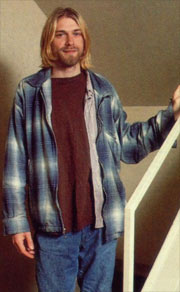
1994 Fashion: Kurt Cobain and the grunge style
In early 1994, the "grunge" manner had completely taken over the American fashion world. A style derived from clothes worn by Seattle stone musicians, grunge was an array of jackets, vests, sweaters, skirts, scarves, and footwear that resembled hiking boots.
Marc Jacobs developed a grunge collection. Gianni Versace did besides, but women institute themselves hard pressed to pay designer prices for what they thought resembled second-hand clothes. While grunge remained popular with the younger crowd in 1994, women over xxx were unimpressed.
By the finish of 1994, women were wearing high heels and dresses fabricated of satin, metal or other high shine fabrics. Feathers and fringe, beads and sequins adorned clothes that hugged the body. 1972 glam was back!
Comfort persisted in the clothes women wore in their downtime. Tights made of spandex, t-shirts and loose sweaters dominated the weekend.
Women yet plant the suit to exist the most useful way to dress for the increasingly faster-paced modern globe. Giorgio Armani figured out ways to tailor clothes that both men and women loved.
As Yves Saint Lauren found out, using real fur was an invitation for passionate protests from animal rights activists. During his first visit to the U.Due south. in 12 years, he was greeted by angry picketers who took issue with the fox trim on his jackets that were on display at a New York Urban center Saks Fifth Avenue shop.
Fashion in 1995

1995 Fashion Magazine Embrace (May)
Men and women did not blindly follow fashion designers in 1995. Certain, they still dressed up for weddings and special events, but for the most part anybody wore coincidental clothes. T-shirts were seen everywhere.
Women ignored the supposed hemline of the times and interchanged brusque and long skirts when they felt like it. Women were less interested in provocative clothing, trading in sheer fabrics and alpine heels for comfort and liberty. Some women looking to enhance their curves, however, were quite fond of the push-up bra.
The American fashion buying public had all but lost interest in high fashion. Designers spent millions on lavish shows, parading supermodels around in fashions that no mutual woman would be able to afford, allow alone habiliment. To the average woman, way shows became something of an amusing novelty and not really something to exist taken seriously.
Expensive labels gave way to applied ones similar The Gap. Many cost-cutting women were getting their vesture from Wal-Mart, Yard-Mart and Caldor. They would often "cross shop", meaning they would get i or two pieces in an upscale store, then supplement it with a cheaper pair of jeans or a sweater.
Almost every designer that fabricated a profit focused on lower-priced styles. Geoffrey Beene made lower-priced styles for men and women that were sold in 135 shopping malls.
The "dress for success" style that dominated previous decades practically disappeared in 1995. Increasingly, companies were offer "coincidental Fridays" in which employees were immune to wear jeans to piece of work.
And although sportswear had been around for 50 years, designers like Calvin Klein, Donna Karan and Ralph Lauren were still finding ways to put a new twist on an onetime plot.
Mode in 1997

1997 Manner: Vogue January. Mag Cover
Pop fashions in 1997 included casual wearing apparel at the role and a return to the styles of the 1970s.
Men, women, children — most everyone took to wearing baseball caps in 1997. Bending the pecker was necessary, but it was too common to see people wearing them backwards, or even sideways (in an ironic sort of fashion).
Monochromatic shirt and tie combinations kept men's clothing subtle. But close-plumbing equipment knit tops, flared pant legs and tall platform shoes reminded u.s. of an era two decades prior.
The fashion industry was shocked past the senseless murder of Giovanni Versace on July 15.
Interest in fashion, which had peaked in the 1980s, had been waning for several years. To restore that interest, designers created styles to fit an increasingly relaxed era.
For women in the workplace, the pants arrange replaced, one time and for all, the traditional jacket/skirt combo.
Sportswear like coincidental jackets, t-shirts, sweatshirts and lawn tennis shoes (ie: sneakers, trainers) were acceptable for many occasions.
Even for formal settings, elaborate dresses were inappropriate. Women chose the "trivial black dress", with or without subtle embroidery. Luxury was expressed quietly, with precious fibers like silk and cashmere.
Surprisingly, fur was making a improvement, despite constant anti-fur protesting. But it wasn't the full length glaze of yore, the fur was used more for trim, handbags and coincidental uses.
Fashion in 1999
The fashion globe's focus in the terminal year of the millennium was on mergers and acquisitions much more than fabrics.
Upwardly until the 1980s, smaller fashion firms were able to stay in business organisation by being more flexible and being able to react quickly to the newest trends. Since and so even so, these companies had struggled to keep upward and many manner boutiques merged into huge corporate enterprises.
The biggest acquisition of 1999 featured Gucci, who was virtually purchased by Louis Vuitton. Gucci ended upward going to Pinault-Printemps-Redoute instead.
In the U.South., Kasper of New Jersey bought the Anne Klein Company and Estee Lauder swept up Stila, an emerging cosmetics company.
Sportswear remained the ascendant choice worldwide. Some sportswear designers tried dressier looks to little fanfare. Women wore fitted tops over t-shirts or tank tops, while jeans featured embroidery and other decorations.
In order to spice up their sportswear, women were turning to colorful accessories. Brightly colored handbags, glittering hair ornaments and jewelry, such as arm bands and bracelets had made a strong improvement.
The Pashmina shawl, made from the finest cashmere on the planet, was a huge success. It came in bright pastel shades and was worn over casual clothes equally well as evening article of clothing. Fifty-fifty thought prices of this shawl could easily elevation $100, they all the same won worldwide acceptance as a luxury fashion particular.
With the impending turn-of-the-millennium parties approaching, fashion designers put all of the efforts into evening wear. Dresses were sleek, in all lengths, made of luxurious fabrics. The were adorned with embroidery and beads.
Past the stop of the century the business suit in the office had all just vanished. Men and women both were embracing the new "business organisation coincidental" look, not but for employee condolement, but every bit a tactic to recruit younger generations.
Supermodels no longer carried the same sway that they used among the fashion industry. Instead, movie stars were the trendsetters. Stars such as Gwyneth Paltrow and Nicole Kidman were featured more prominently in fashion magazines by 1999.
1990s Women's Fashion Pictures
CLICK IMAGE TO Enlarge
1990s Men's Fashion Pictures
CLICK IMAGE TO Overstate
0 Response to "1970s Fashion Ads 1977 Skokie Illinois"
Post a Comment